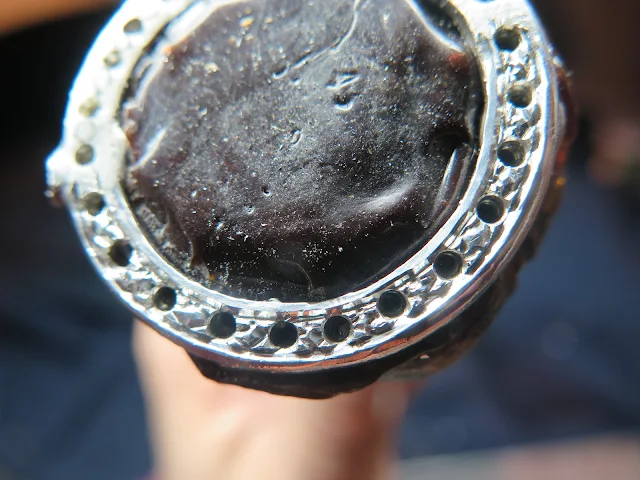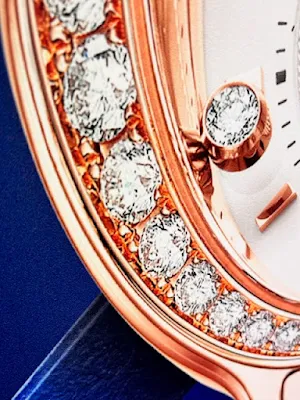Onglette gravers are only blades of steel, but can they do some pretty wonderful metal cutting. I always say, "What do they don't do", is a better term.
Let me now delve into the many uses of these extraordinary setting tools.
I'm not tutoring gemstone settings in this essay, I'm just showing you what these basic gravers are able to do. I've selected mostly 'non-CAD' Diamond Setting patterns and techniques in these 47 photos.
"YOU WANT 'GRAVER DETAILS', CAN YOU HANDLE THESE DETAILS?"
=========================================
For the first photo, I am showing that not everything is done via CAD. In fact, I'm shying away from this process during most of these photos (only 'when & where' mentioned).
This originally this was a very large round silver disk, with a few holes in it.
I used Onglette #1 and #2 gravers. I initially cut out a pattern with the very thin #1 graver. In keeping with the 'rough-cutting' processes, I cut out a square in between each of the holes. I cut this design 2-3 times, each time going deeper resulting in a 'O<>O' all around the disk.
Upon completing this pattern, I then used my Onglette graver #2 to widen the rough-cutting until the result is what you are seeing here. I Bright-Cut the <> and made it look like a shiny square.
When the holes are made to the size each of the diamonds, lower them into the holes carefully. With 'separating & pressing the metal' over the girdle with your Flat Graver, you now have 'strong' beads as shown below.
These 'separating techniques' will give you a pattern just like the design that was featured in a mall 'advertising kiosk'. All that is left is to burnish the beads, with greatest care.
Again, these patterns were not 'CAD' created.
Here are the 'beads' so nicely burnished, by using a "77B, cup-bur".
My great ORCHID friend (Taf Schafer) took a photo of a previously written 'introduction' to an essay that I wrote. This is an valuable essay opening...Thank you Taf Schafer.

At every opportunity, STOP your metal cutting and reshape your gravers to keep them in pristine condition. The desired shape is to be seen in the following photos.
I always maintain a fine contoured point of a graver, not some thick unmanageable piece of steel.
A Milgrain gives a nice finish to the Bright-Cutting.
When I'm putting my graver to the polishing paper, I always apply a heavy downward pressure to the rubbing. This way the graver will get a great finish to the steel.
This the desired angle of my "Right-Sided, cutting blade". All of my cutting is now put on the "Right-Side" of the Onglette graver. The left-side is never touched in the course of cutting.
This "Right-Side" can now cut curves with no problem. There is no need to use your Flat graver on delicate curves, if you attempt this maneuver, you will have a ripple effect.
Here you see the minute shavings of metal being removed. Don't even attempt to set any gemstones while you are cutting the metal. You will be defeating the whole purpose of Bright-Cutting.
This is another version of a "Fish-Tail" pattern. The original design had no patterns to help me cut the metal. Remember, that there no Flat gravers being used in this exercise.
There is no way a Flat graver can cut curves, so don't attempt or try it. It isn't going to be successful.
Here are new Onglette gravers just as they look after being bought. The numbers refer to the thicknesses of the blade. The yellow blade root was bought for other purposes, not for now!
The "HSS" refers to "High Speed Steel" metal.
The numbers on the wooden sticks display the sequence of grits of the polishing paper. Number #240 is the most course, then leading to the finest paper #1,200.
I use a soft leaded pencil, to make the paper even more soft for the 'pencil rubbing'.
The 'soft' pencil lead is pushed into the pores of the paper. Each level of rubbing makes the paper even more smoother for making the steel blade just that much more polished.
These gravers are at different lengths, but once these are in their handles, they look the same.
As my diagram suggests, all of my gravers are HSS. They last longer and the steel doesn't get worn down too fast.
No matter the thickness of each, they are all made for different purposes.
This long sliver of metal is because of the cutting with my Onglette #2 graver.
With my "Right-Sided" graver I can cut curves and circles. No other blade can do such decorative cutting.
These two uncut blades will definitely assist me in my specialized metal cutting..JPG)
This ultra-thin graver is what I'll be using in carving metal to make new beads. These are seen in various photos in this essay.
.jpg)
This photo shows how the Gypsy Bezel was "Bright-Cut". There just isn't another blade that will do this detailed work
Would you believe that this was just a flat plate with a few holes in it?
All I used were my two Onglette blades, plus a few decades of experience.
This is my close-up of my (favourite) "Right-Sided" Onglette #2 graver. The right side is at a different cutting angle, it is made to cut ONLY ON THE RIGHT SIDE.
Even on Bezel setting, I'll use my modified graver to clean the inside of the Bezel. Some setters just ignore this important step in their 'hand-carving or cutting'.
This process is named "Pre-Cutting" as all of the cutting is done before any gemstone setting has taken place.
This is named "Two-Bead Setting" as there are only two beads holding each stone. All of this cutting must be initiated long before any stones go into the metal.
With these two little beads, the stone will not fall out. For decoration, I applied a Migraine to the edges.
I used an Onglette #1 graver to start the first stages of cutting. Afterwards I used my Onglette #2 to finalize the side cuttings.
For more decoration, I created many 'unused beads' and burnished them as well.
With a Bead forming tool that is made from an Onglette #2 graver. The bottom of the graver has a 'rounded' point to prevent breakage during this process.
You can see the deep hole just behind the two new beads, this is where the Onglette blade went into the metal.
As before, keep your bench-grinder ready to modify your gravers. I call this "Graver Maintenance".
After many and 'graver polishing', the graver is now able to "Bright-Cut" the metal.
This a photo of the early stages of graver-preparation, there is much cleaning to do with the Emery & Polishing Papers.
With the Onglette graver #1, I experimented with this "Azure" pattern.
BTW, I started to cut this metal with the #1 Onglette, then proceeded with the regular cutting blades.
Here is another "Bright-Cutting" technique in using a "Right-Sided" cutting blade. The inner circle is just a reflection of the cutting.
As all of the cutting has been completed, it's time to set the soft gemstones of your choice,
You can use either Genuine Emeralds, Blue Zircon or Amethyst. There is no chance of breakage as your gravers can now "take a nice little well deserved holiday".

%20(1).JPG)








.jpg)
%20(1).JPG)
.JPG)
.jpg)
.JPG)
.JPG)
.jpg)
%20(1).jpg)
%20(1).jpg)
.jpg)
.JPG)

.JPG)
.jpg)





.jpg)









.jpg)
.jpg)






No comments:
Post a Comment